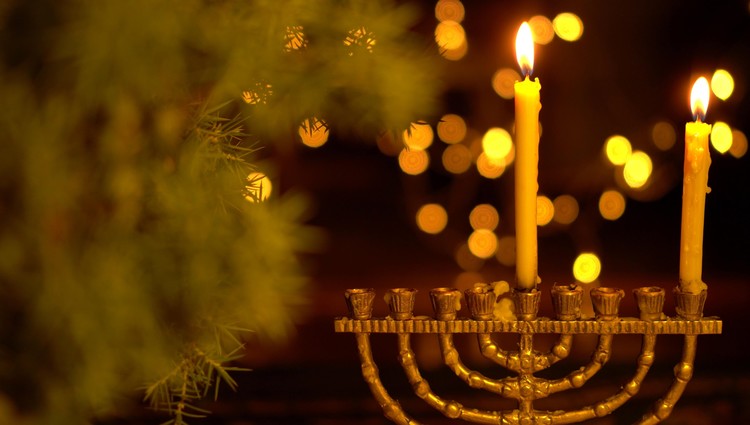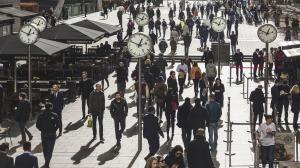
AM and PM Explained
How does the 12-hour clock system work? Is midnight 12 am or 12 pm?
The first day of Hanukkah marks the start of Hanukkah, also known as Chanukah or Festival of Lights. Hanukkah is an eight-day Jewish observance that remembers the Jewish people's struggle for religious freedom.

On the first day of Hanukkah, only the shammash and the first candle are lit.
©iStockphoto.com/Fevziie Ryman
Jewish communities worldwide celebrate Hanukkah between the 25th day of the month of Kislev to the second day of the month of Tevet in the Hebrew calendar. Jewish families celebrate this holiday by lighting a special Hanukkah menorah, a candelabrum with holders for 8 candles, one for each day of celebration, plus a ninth, the shammash or “server”, used to light the others during Hanukkah. One candle is lit on the first night, two on the second, three on the third, through to the eighth night when all are lit.
A special prayer is recited during the lighting and while the candles burn it is a time for songs and games, including the four-sided toy called dreidel. The dreidel is popular among children. Some children try to knock other players' dreidels down while others try to spin as many dreidels as possible at the one time. Other customs include gift-giving, especially to children, and decorating the home – much like the Christmas celebrations in Christian homes around this time of the year.
Food that is eaten around this time of the year include sufganiot (Hanukkah donuts), potato latkes (pancakes), Hanukkah candy, mandelbrot (a firm, cake-like cookie that can be made into a loaf and sliced like a hard bread), and rugelach (a type of pastry that can be used with different fillings, such as raisins, walnuts, cinnamon or chocolate). Dairy products are also often eaten during this period.
The first day of Hanukkah is not a public holiday in Israel but it falls within the school holiday period. This event is also not a public holiday in countries such as Australia, Canada, the United Kingdom and the United States. Some Jewish schools in these and other countries have their school vacation fall around the same time of Hanukkah.
Hanukkah commemorates the successful rebellion of the Jewish people against the Syrians in the Maccabean War of 162 BCE, but the military associations of this festival are played down. What is really being celebrated is the survival of Judaism. After the Jewish people's victory they ritually cleansed and rededicated the Temple, then re-lit the menorah or “perpetual lamp”; hence one of the other names for this celebration, the Feast of Dedication (Hanukkah means “dedication” in Hebrew).
The story is told that although there was only enough consecrated oil to keep the lamp burning for one day and it would take 8 days to get more, the small bottle of oil miraculously lasted for the entire 8 days. It is for this reason that Hanukkah is also known as the Feast of Lights. The last day of Hanukkah, which marks the end of Hanukkah, falls on the eighth day of this period.
The eight-branched Hanukkah menorah, or candle holder, is an important element that symbolizes the tradition of Hanukkah. It relates well with why the holiday is called “the festival of lights”. The menorah is lit from the left side to the right and people say blessings when the menorah is lit. There are many different styles of the menorah – in many cases the ninth holder, known as the shammash (helper candle), is in the middle or to the left side.
The dreidel is a popular toy symbolizing the Hanukkah period. It is a spinning top with a different Hebrew letter inscribed in each of its four sides – the four letters form an acronym meaning “a great miracle happened here”. Some popular songs associated with Hanukkah in English-speaking countries include “Dreidel, Dreidel, Dreidel” and “Chanukah, Oh Chanukah”. Some songs in Israel include "Hanukkiah Li Yesh" ("I Have a Hanukkah Menora"), "Kad Katan" ("A Small Jug"), and "S'vivon Sov Sov Sov" ("Dreidel, Spin and Spin").
In the Jewish diaspora—Jewish communities outside of Israel—an extra day is usually added to religious observances, with the exception of Yom Kippur, which lasts only one day worldwide, and Rosh Hashana, which is celebrated over two days in both Israel and the diaspora.
This custom has its roots in ancient times when the beginning of the months in the Jewish calendar still relied on the sighting of the crescent Moon following a New Moon.
The beginning of a new month was determined by the Sanhedrin, the supreme court of ancient Israel in Jerusalem. Once the date was published, messengers were dispatched to spread the news among Jews living abroad. Since this process took some time, it was decreed that Jews outside of ancient Israel were to observe every holiday for 2 days to make sure that the rules and customs applicable to each holiday were observed on the proper date. This rule is still observed today.

How does the 12-hour clock system work? Is midnight 12 am or 12 pm?

Why do many countries set the clocks back and forth an hour twice a year?

Why are there 12 months? How long are they, and what do the month names mean?

Coordinated Universal Time (UTC) is the basis for civil time today. This 24-hour time standard is kept using highly precise atomic clocks combined with the Earth's rotation.